Wastewater Reuse for Phosphate Mine
Mining operations can produce a large amount of wastewater in the form spent liquor that requires treatment. The wastewater stream has a high concentration of contaminants that need to be separated from the water before it can be discharged or reused.
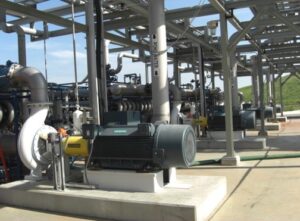
Dynatec provided a wastewater reuse system for a phosphate mining operation that treats 5 million gallons of wastewater per day. The customer was motivated to put a treatment/reuse system in an effort to separate a portion of the compounds in the wastewater for reuse. Also, the desired water quality for discharge met requirements for reuse of several water users in the plant.
Wastewater Reuse for Phosphate Mine
Dynatec was asked to conduct a pilot to study the feasibility of using membrane technology to purify the wastewater so that it could be reused in mining operations at the site. After several months of piloting, Dynatec was commissioned to supply five ultrafiltration skids, each capable of producing one million gallons per day of permeate. The ultrafilters were a part of the reuse system that also includes, nanofiltration and reverse osmosis to produce water and product for reuse.
Due to the highly saturated wastewater stream, the pH of the wastewater was maintained at 1.8 s.u. to keep specific contaminants from precipitating in the membrane systems. The ultrafilters have successfully operated at this pH for over 10 years and their life span has not been negatively impacted by the nature of the wastewater.
The high strength spent liquor is processed through a series of membranes from UF to NF to RO. The customer has found reuse applications for the reject and permeate from the membrane systems. The final system has alleviated concerns of future environmental infractions and has saved the customer money.
Contact us today to discuss your wastewater application.
https://www.dynatecsystems.com/technologies/recovery-and-reuse/
Tank Truck Wash Water
A tanker truck operator built a new operations terminal part of which contains a wash facility to wash the interiors of trucks and the exterior of the tankers and tractors. The operation is a contract hauler so a wide variety of liquids will end up in the wastewater.
The facility obtained a sewer discharge permit that had restrictive oil and grease and metals limits but also had a daily discharge volume limit of 7,000 gallons.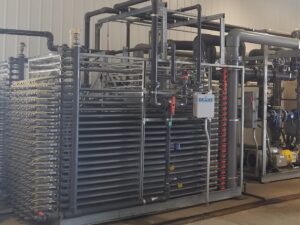
Among the commodities transported are oil products, sugar, chemicals, acid, and caustic, as well as many other organic products. The system design, therefore, had to accommodate all these potential contaminants in the water.
The system design includes free oil separation, pH control and final treatment using ultrafiltration (UF). This treatment was designed to treat the wastewater to meet the sewer discharge limits despite variations in the waste stream.
Water having had the free oil, suspended solids, and emulsified oils removed and having had the pH controlled is suitable for use as wash and first rinse water in the tank washing operations. This, therefore, became part of the system design to conserve water and to enable the facility to meet the sewer volume discharge limitation. Because this was a new facility, there was not an opportunity to complete treatability studies on the wastewater. Dynatec Systems prior experience in similar/like applications served as the basis of design.
Tank Truck Wash Water Ultrafiltration
The ultrafilter is configured in a crossflow (tangential) flow process, a membrane pore size of 0.07 micron. It is used to reject colloidal and emulsified components in water. A high rate of flow across the membrane is maintained to cause turbulence. This, in turn, prevents fouling of the membranes.
For many waste applications like this one, a tubular membrane is specified to prevent the possibility of plugging of the membrane element and to concentrate the contaminants to a high concentration.
Tank Truck Wash Water Results
The system continues to meet the demanding discharge requirements. About 50% of the water produced is reused for wash and first rinse, both for the interiors of the tankers and for the exteriors of the vehicles.
The system is simple to operate and maintain. Variations in the quality of water being fed to the system caused by different chemicals being cleaned from the tankers does not cause variations in the quality of discharge.
Contact Dynatec Systems today to discuss your wastewater application.
https://www.dynatecsystems.com/technologies/membrane-technologies/ultrafiltration-systems/
Chemical Manufacturer Wastewater Treatment
A chemical manufacturer issued a PO for a new wastewater treatment system from Dynatec. Our customer is in the process of a major plant expansion and needed to meet new, stricter discharge limits. The wastewater is high in oil and grease, BOD, and COD. The new system will consist of an ultrafiltration system followed by a membrane bioreactor (MBR). The performance of this system was proven over several months of piloting. The results confirmed the selection of UF followed by MBR. The BOD in the permeate was regularly non-detect, down from as high as 40,000ppm in the raw wastewater. All other discharge limits were easily met.
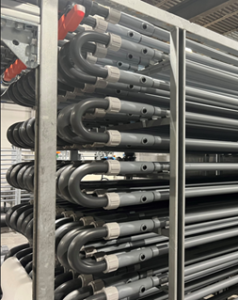
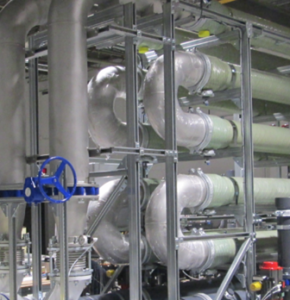
Chemical wastewater treatment utilizing membrane systems that range from selective separation of product to wastewater treatment and reuse. Dynatec Systems has provided many different chemical wastewater solutions.
- Ultrafiltration (UF), Nanofiltration (NF) and Reverse Osmosis (RO) for selective separation of product for recovery
- MBR biological treatment
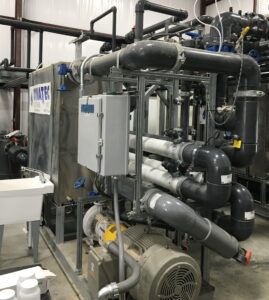
- Wastewater reuse with MBR
- Conversions of existing systems to MBR
- Expand existing bioreactor treatment capacity
- Improve discharge quality
- Produce water for reuse
- Reduce surcharge
- High purity reuse with MBR and RO
Contaminants Removed
- Organics
- Inorganic solids
- Phenol
- Solvents
- Oils
- Acids
Ultrafiltration offers the following advantages over conventional separation:
- No chemical required
- Very little labor required
- Simple mechanical process
- Less sludge
- Ability to concentrate the retentate for beneficial use
- Less space required
- Overall lower operating costs
Dynatec specializes in extensive RO and NF membrane systems to remove soluble components of wastewater that may not have been removed by primary treatment. In most cases, the purified water can be reused.
RO is capable of rejecting soluble constituents of aqueous streams, such as:
- Bacteria
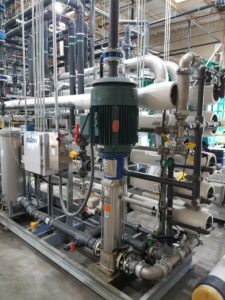
- Salts
- Sugars
- Proteins
- A wide range of organics and colors
- Improves the color, taste and properties of the fluid
RO can be used to purify fluids such as ethanol, which will pass through the reverse osmosis membrane, while rejecting other ions and contaminants from passing.
RO/NF systems
The most common use for reverse osmosis is in purifying water. It is used to produce water that meets the most demanding specifications. This differs significantly from other RO systems that are often only designed to treat potable water. Our system is specifically designed to accommodate:
- Minimize reject volume
- Variable characteristics
- Minimize fouling
RO and NF Technology
RO uses a membrane that is semi-permeable, allowing the fluid that is being purified to pass through it, while rejecting the contaminants that remain. Most NF and RO systems are operated in crossflow to allow the membrane to continually clean itself.
Integrated clean-in-place (CIP)
The membrane skid has an integrated CIP system on the skid. This is especially important for wastewater reuse systems because the cleaning frequency of the skid is often higher than in other RO applications. With an integrated CIP system, cleaning is fast and easy, minimizing the operator’s time.
Tubular Configuration:
- Higher permeate rate
- Lower rates of fouling
- Higher concentration of retentate
- Easier to clean
- Longer membrane life
- Low operating cost
To discuss your wastewater treatment solution, please contact us today.
Landfill Leachate Treatment Expansion
Dynatec just shipped two new Ultrafiltration systems for a landfill leachate treatment expansion project. These skids are part of an expansion at an existing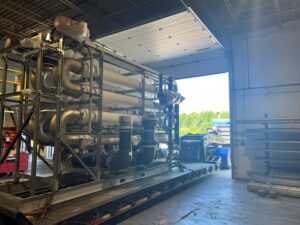 leachate treatment plant. The existing Dynatec system treats 250,000 gallons per day. This expansion will allow them to filter 500,000gpd on average. The primary target contaminants at the landfill are heavy metals. The existing UF system has allowed the landfill to successfully reach their discharge limits for metals. Due to this success, they have contracted Dynatec as the leachate production has increased.
leachate treatment plant. The existing Dynatec system treats 250,000 gallons per day. This expansion will allow them to filter 500,000gpd on average. The primary target contaminants at the landfill are heavy metals. The existing UF system has allowed the landfill to successfully reach their discharge limits for metals. Due to this success, they have contracted Dynatec as the leachate production has increased.
Dynatec Systems industry-leading tubular ultrafiltration (UF) system is used to treat a broad range of industrial wastewater by separating insoluble components from waste streams. As a cost effective and simple solution for separating insoluble components and colloidal contaminants from a waste stream, wastewater UF offers significant advantages over conventional separation. It is a useful process that does not require chemicals or much space to separate insoluble contaminants.
UF is a pressure-driven process that removes the following from wastewater and other solutions:
- Emulsified oils
- Metal hydroxides
- Colloids
- Emulsions
- Dispersed material
- Suspended solids
- Other large molecular-weight materials
Ultrafiltration systems are also capable of concentrating:
- Bacteria
- Some proteins
- Some dyes
- Colloidal or emulsified components
Ultrafiltration systems excels at the clarification of solutions containing:
- Suspended solids
- Bacteria
- High concentrations of macromolecules including:
- Oil and water
- Fruit juice
- Milk
- Whey
- Electro-coat paints
- Pharmaceuticals
- Poly-vinyl alcohol and indigo
- Potable water
- Tertiary wastewater
Ultrafiltration offers the following advantages over conventional separation:
- No chemical required
- Very little labor required
- Simple mechanical process
- Less sludge
- Ability to concentrate the retentate for beneficial use
- Less space required
- Overall lower operating costs
Tubular Configuration:
- Higher permeate rate
- Lower rates of fouling
- Higher concentration of retentate
- Easier to clean
- Longer membrane life
- Low operating cost
https://www.dynatecsystems.com/industries/landfill-leachate-treatment/
Contact Dynatec for your landfill leachate treatment solution today.
Chemical plant wastewater treatment
Chemical plant wastewater treatment was failing to meet discharge limits, installed a Dynatec UF system to separate emulsified fats, oils, and grease (FOG) from their permeate. The raw wastewater has more than 2,000ppm of emulsified FOG with peaks much higher at times. The system consists of four UF units and related components. The system currently treats 66gpm, but all 4 units are expandable. The permeate is free of FOG and is acceptable for discharge.
https://www.dynatecsystems.com/technologies/membrane-technologies/ultrafiltration-systems/
Chemical wastewater treatment utilizing membrane systems that range from selective separation of product to wastewater treatment and reuse. Dynatec Systems has provided many different chemical wastewater solutions.
Chemical Wastewater Treatment Solutions
- Ultrafiltration (UF), Nanofiltration (NF) and Reverse Osmosis (RO) for selective separation of product for recovery
- MBR biological treatment
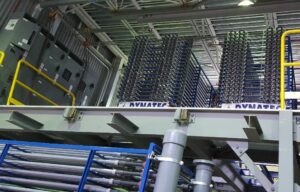
- Wastewater reuse with MBR
- Conversions of existing systems to MBR
- Expand existing bioreactor treatment capacity
- Improve discharge quality
- Produce water for reuse
- Reduce surcharge
- High purity reuse with MBR and RO
Contaminants Removed
- Organics
- Inorganic solids
- Phenol
- Solvents
- Oils
- Acids
Ultrafiltration offers the following advantages over conventional separation:
- No chemical required
- Very little labor required
- Simple mechanical process
- Less sludge
- Ability to concentrate the retentate for beneficial use
- Less space required
- Overall lower operating costs
Dynatec specializes in extensive RO and NF membrane systems to remove soluble components of wastewater that may not have been removed by primary treatment. In most cases, the purified water can be reused.
RO is capable of rejecting soluble constituents of aqueous streams, such as:
- Bacteria

- Salts
- Sugars
- Proteins
- A wide range of organics and colors
- Improves the color, taste and properties of the fluid
RO can be used to purify fluids such as ethanol, which will pass through the reverse osmosis membrane, while rejecting other ions and contaminants from passing.
RO/NF systems
The most common use for reverse osmosis is in purifying water. It is used to produce water that meets the most demanding specifications. This differs significantly from other RO systems that are often only designed to treat potable water. Our system is specifically designed to accommodate:
- Minimize reject volume
- Variable characteristics
- Minimize fouling
RO and NF Technology
RO uses a membrane that is semi-permeable, allowing the fluid that is being purified to pass through it, while rejecting the contaminants that remain. Most NF and RO systems are operated in crossflow to allow the membrane to continually clean itself.
Integrated clean-in-place (CIP)
The membrane skid has an integrated CIP system on the skid. This is especially important for wastewater reuse systems because the cleaning frequency of the skid is often higher than in other RO applications. With an integrated CIP system, cleaning is fast and easy, minimizing the operator’s time.
Tubular Configuration:
- Higher permeate rate
- Lower rates of fouling
- Higher concentration of retentate
- Easier to clean
- Longer membrane life
- Low operating cost
To discuss your wastewater treatment solution, please contact us today.
Turnkey Solutions
Turnkey solutions provided by Dynatec include equalization tank, oil water separator, ultrafiltration (UF) process tank, UF system, and permeate and concentrate tanks. The customer, an industrial research facility, had a wastewater treatment facility that also treats the waste from several other manufacturers that occupy buildings nearby, recently purchased an UF system from Dynatec. The UF system replaced a DAF system that was not effectively handling the contaminant load from these facilities, including oily waste, heavy metals, and suspended solids due to the frequent changes in the wastewater characteristics. The customer also chose to have Dynatec install the system. The UF system has allowed them to meet their discharge requirements with less operator attention and effort.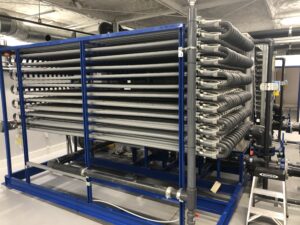
Dynatec’s team of mechanical, chemical and electrical engineers have decades of experience to provide everything you need, from start to finish. This includes evaluation, system design, installation, system startup and training. Our focus has always been to produce the most cost-effective long-term answer for our customer. All turnkey systems are custom designed and installed for your specific needs.
Two different sets of disciplines are employed for this stage of the process. First, years of process experience produce effective process design. Our ownership and operation of treatment systems produces invaluable field experience that is translated into operator-friendly equipment. Next, the process design is translated into a complete integrated treatment systems by our experienced engineering staff.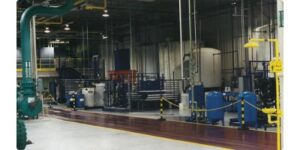
- Single source of responsibility
- Problem evaluation
- Process and system design
- Equipment
- Installation service
- System startup
- System startup consists of a three-step process:
- The equipment is commissioned by proving each of the field instruments
- The equipment is wet-tested
- Equipment is operated on process fluid to prove operation under normal conditions
- Training by Dynatec engineers
Dynatec obtains membranes from a wide variety of suppliers, always aware of the need to produce lowest lifetime cost. Our suppliers produce membranes in a variety of materials, as well as a number of configurations for most effective solutions. In addition, Dynatec procures other equipment required to complete the project.
Dynatec manufactures modular equipment so that installation costs are kept to a minimum. Supervised by experienced competent engineers. Our usual method of operation is to hire local contractors approved by our customer.
Proven Installed Turnkey Solutions
At Dynatec, we are not just experts in providing reliable equipment for industrial applications, we also provide the proven solutions that our global clients need.
For more information on our design-build turnkey solutions for your install, please contact us today.
Contract Service – DBOOM
A contract service – (DBOOM) system owned and operated by Dynatec has now been in operation for 25 years. The system was provided to the customer, a manufacturer of bearings, on a Design, Build, Own, Operate, Maintain (DBOOM) basis. Dynatec designed and installed the system 25 years ago and has been operating and maintaining it since. The customer pays Dynatec a few cents per gallon of wastewater treated. The DBOOM arrangement has been an attractive option to several customers over the years. It allows them to achieve the wastewater treatment goals without a capital expenditure and without operating and maintenance responsibility. Another Dynatec system has been successfully operating on a DBOOM basis at a large automotive company’s stamping plant for 20 years.
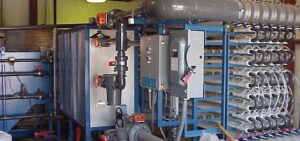
Design-Build-Own-Operate-Maintain complete wastewater treatment system solutions offers the assurance of a well-run operation with little risk and no capital required.
Complete Wastewater Solutions
Since 1978, Dynatec has supplied complete wastewater treatment systems for industrial applications and in that time, we have successfully installed over a thousand systems. Since 1993, we have provided DBOOM solutions that are completely designed, built, owned, operated and maintained by Dynatec.
Contract Service (DBOOM) benefits: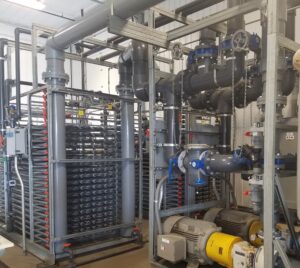
Little Risk
Get the assurance you need for a well-run and well-operated system. Offering minimal risk with great convenience to the customer. Dynatec owns, operates and maintains the equipment, supplying complete wastewater treatment systems on a contract basis. Each contract is tailored to the owner’s unique requirements.
Cost-effective
Our contract service agreements offer a reliable means of both reducing and fixing costs. This allows our clients to accurately predict operating costs and provide the option for purchase of the system at the end of the contract term.
Compensation, in the form of monthly payments, is based on the amount of water treated, purified and discharged to sewer or reused. The per-gallon charge fixes the total cost for processing the waste stream.
Minimal Liability
With minimal operator attention required, a locally-employed Dynatec technician will attend to the system on a daily basis to check for proper functioning, the need for service or maintenance and water quality.
Your Dynatec technician covers all attention, care and maintenance required by the system to ensure compliance with sewer discharge standards. Contaminants removed are disposed of through an approved and licensed disposal firm.
Contract Service – DBOOM project begins the same way all of our projects start. First, we obtain thorough information that helps us characterize your waste stream and the treatment requirements. Once treatability work is performed, we develop a system design and proposal. At that time, the terms of the contract can be negotiated. Dynatec can confirm the project requirements, and implement on-site pilot testing, when necessary.
Contract Service – (DBOOM)
- No risk
- No capital employed in non-performing assets
- No need to operate or maintain equipment
- Assurance of a well-run and well-operated system
- Significant cost savings
- If waste is presently being hauled to a commercial waste treatment facility, this program will help to considerably reduce costs.
- Costs fixed for the term of the contract
- Lower environmental liability
For more information about Dynatec Systems’ (DBOOM) Design-Build-Own-Operate-Maintain services, please contact us to discuss your opportunity.
RO Concentrate Evaporation
Waste Management’s Atlantic Landfill RO Concentrate Evaporation Project Short Listed for 2022 GWI Industrial Project of the Year
This project utilizes Dynatec’s MBR and RO. The reject from the RO is evaporated using waste heat from the on-site power generation. It is a great project overall and this is a cost effective and sustainable approach to handling RO reject.
WAVERLY, VA – WM’s 120,000GPD leachate evaporation project, developed in partnership with Heartland Water Technology, was shortlisted for the Global Water Intelligence’s 2022 Industrial Project of the year. A 120,000GPD (450m3/d) evaporation solution for reverse osmosis (RO) concentrate at the Waverly landfill site in Virginia, US., this project addresses the challenges of RO concentrate waste stream treatment and disposal.
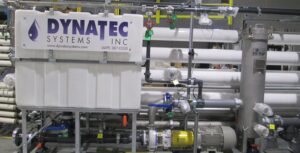
Dynatec specializes in extensive industrial reverse osmosis (RO) membrane systems and nanofiltration (NF) membrane systems to remove soluble components of wastewater that may not have been removed by primary treatment. In most cases, the purified water can be reused.
RO is capable of rejecting soluble constituents of aqueous streams, such as:
- Bacteria

- Salts
- Sugars
- Proteins
- A wide range of organics and colors
- Improves the color, taste and properties of the fluid
This process is commonly used to purify water and remove salts and other impurities. It can be used to purify fluids such as ethanol, which will pass through the reverse osmosis membrane, while rejecting other ions and contaminants from passing.
Industrial Reverse Osmosis/Nanofiltration systems
The most common use for reverse osmosis is in purifying water. It is used to produce water that meets the most demanding specifications. This differs significantly from other RO systems that are often only designed to treat potable water. Our system is specifically designed to accommodate:
- Minimize reject volume
- Variable characteristics
- Minimize fouling
RO and NF Technology
RO uses a membrane that is semi-permeable, allowing the fluid that is being purified to pass through it, while rejecting the contaminants that remain. Most NF and RO systems are operated in crossflow to allow the membrane to continually clean itself.
Integrated clean-in-place (CIP)
The membrane skid has an integrated CIP system on the skid. This is especially important for wastewater reuse systems because the cleaning frequency of the skid is often higher than in other RO applications. With an integrated CIP system, cleaning is fast and easy, minimizing the operator’s time.
Contact Dynatec to discuss your wastewater application.
https://www.dynatecsystems.com/industries/landfill-leachate-treatment/
MBR RO for Reuse
MBR RO for reuse, A domestic manufacturer of personal protective equipment is undergoing a major plant expansion. The company now needs to treat their wastewater for reuse as they discharge to a small POTW that could not handle the new volumes or contaminant loading. The new wastewater treatment plant is being built in stages. The first system is a relatively small MBR to handle the first phase of their expanded production. The second system is designed to handle their full-scale production, which will only be several months after the first phase is completed. This system includes an EQ tank, MBR with pre and post anoxic tanks and tubular UF, and RO. The system is designed so that all the RO permeate can be reused while the RO reject can be discharged to the local POTW. One of the goals of the MBR is to reduce nitrates from a high initial concentration to very low levels so that the RO reject will meet that total nitrogen limits for discharge to the POTW. The plant is designed so that future expansion is easily achieved. 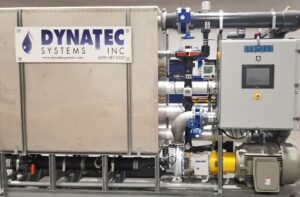
Recovery and reuse systems have been provided by Dynatec Systems to many industries. The ability to recover and reuse water has many benefits.
- Saving on water costs
- Saving on wastewater disposal charges
- Decreased environmental impact
- Protection from regulatory changes
- Decrease dependence on water provider/source
- Ability to expand without affecting water demand
- Overcome water scarcity issues
- Consistently high-quality for water reuse
Ultrafiltration (UF), Membrane Bioreactor (MBR), Nanofiltration (NF) and Reverse Osmosis (RO) are employed by Dynatec for water reuse projects. Water recovery and water reuse has been successfully implemented with industrial and sanitary wastewater streams for: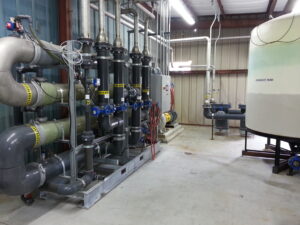
- Cooling tower make up
- Boiler feed
- Irrigation
- Toilet flushing
- Direct potable reuse
- Cleaning/wash applications
- Rinse processes
- Painting processes
- Other plant processes
Recovery and reuse systems provided by Dynatec Systems:
- Resorts, hotels, and retirement homes
- Golf courses
- Automotive companies
- Food and beverage companies
- Apartment buildings
- Landfills
- Mines
- Metal finishing plants
- Aerospace companies
For more information about wastewater reuse, contact us today.
https://www.dynatecsystems.com/technologies/recovery-and-reuse/
Chemical Manufacturer
Chemical manufacturer needed a wastewater treatment plant capable of producing high-quality permeate from raw wastewater. They had high concentrations of oil and grease, Total Suspended Solids (TSS), Biochemical Oxygen Demand (BOD), and Chemical Oxygen Demand (COD). Dynatec designed and manufactured a system including an Ultrafilter (UF) to removed Oil & Grease (O&G) and TSS. An MBR to further treat BOD and COD. The permeate is free of O&G, TSS, and BOD, while COD is greatly reduced. The system was designed so future expansion is easily achieved.


Chemical wastewater treatment utilizing membrane systems that range from selective separation of product to wastewater treatment and reuse. Dynatec Systems has provided many different chemical wastewater solutions.
Chemical Wastewater Treatment Solutions
- Ultrafiltration (UF), Nanofiltration (NF) and Reverse Osmosis (RO) for selective separation of product for recovery
- MBR biological treatment
- Wastewater reuse with MBR
- Conversions of existing systems to MBR
- Expand existing bioreactor treatment capacity
- Improve discharge quality
- Produce water for reuse
- Reduce surcharge
- High purity reuse with MBR and RO
Contaminants Removed
- Organics
- Inorganic solids
- Phenol
- Solvents
- Oils
- Acids
Ultrafiltration offers the following advantages over conventional separation:
- No chemical required
- Very little labor required
- Simple mechanical process
- Less sludge
- Ability to concentrate the retentate for beneficial use
- Less space required
- Overall lower operating costs
Dynatec specializes in extensive RO and NF membrane systems to remove soluble components of wastewater that may not have been removed by primary treatment. In most cases, the purified water can be reused.
RO is capable of rejecting soluble constituents of aqueous streams, such as:
- Bacteria

- Salts
- Sugars
- Proteins
- A wide range of organics and colors
- Improves the color, taste and properties of the fluid
RO can be used to purify fluids such as ethanol, which will pass through the reverse osmosis membrane, while rejecting other ions and contaminants from passing.
RO/NF systems
The most common use for reverse osmosis is in purifying water. It is used to produce water that meets the most demanding specifications. This differs significantly from other RO systems that are often only designed to treat potable water. Our system is specifically designed to accommodate:
- Minimize reject volume
- Variable characteristics
- Minimize fouling
RO and NF Technology
RO uses a membrane that is semi-permeable, allowing the fluid that is being purified to pass through it, while rejecting the contaminants that remain. Most NF and RO systems are operated in crossflow to allow the membrane to continually clean itself.
Integrated clean-in-place (CIP)
The membrane skid has an integrated CIP system on the skid. This is especially important for wastewater reuse systems because the cleaning frequency of the skid is often higher than in other RO applications. With an integrated CIP system, cleaning is fast and easy, minimizing the operator’s time.
Tubular Configuration:
- Higher permeate rate
- Lower rates of fouling
- Higher concentration of retentate
- Easier to clean
- Longer membrane life
- Low operating cost
https://www.dynatecsystems.com/technologies/membrane-technologies/ultrafiltration-systems/
